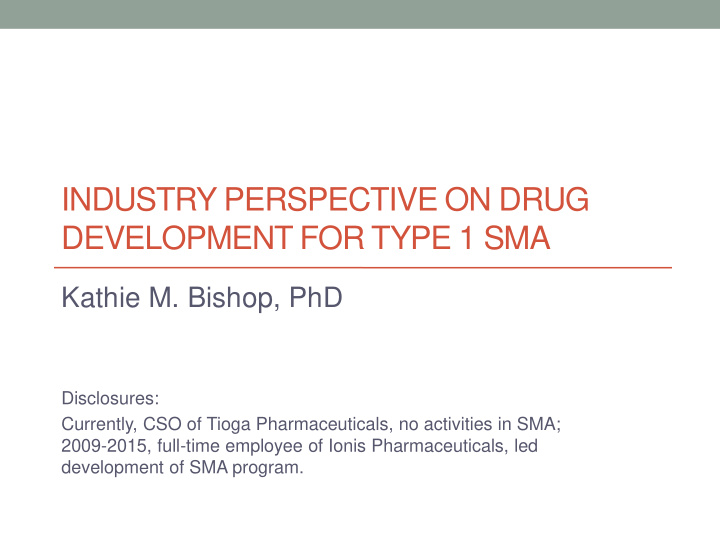



INDUSTRY PERSPECTIVE ON DRUG DEVELOPMENT FOR TYPE 1 SMA Kathie M. Bishop, PhD Disclosures: Currently, CSO of Tioga Pharmaceuticals, no activities in SMA; 2009-2015, full-time employee of Ionis Pharmaceuticals, led development of SMA program.
Outline Patient population for inclusion in trials Control group Outcome measures Biomarkers/PROs Challenges Future?
Drug Development in Type 1 SMA Responsibility to provide CLEAR evidence of efficacy and safety Heterogeneity of disease Small patient population Severe, very rapidly progressing Standard of care Ethical issues
Patient population • Severe, rapidly progressing disease with permanent ventilation or death the eventual outcome • Rare disease (estimated 300 SMA Type 1 births/year in EU; 200 in US) • Heterogeneous disease: • SMN2 Copy number 2 versus 3 • Even within Copy number, is unexplained variability, not yet explained by other factors • Variations in standard of care (country to country, but also site to site and parental preference) compound this variability • Treatment as early as possible likely to provide the best potential for benefit • Even at symptom onset, neuronal loss and degeneration • Depending of mechanism, may require some time for effect • Limit criteria to early = limits ability to enroll study
Control group • May depend on: • Size of drug effect expected • Disease-targeted therapy versus symptomatic treatment • Endpoints used • Placebo- or sham-controlled (imbalance in randomization) • Historical control (standard of care; contemporaneous history; pre-specified; lack of robust, multi-center studies in Europe?) • In some cases, ethical issues with conducting a placebo/sham randomized trial – balance with need to provide conclusive evidence of efficacy • Severe, rapid progression not conducive to to cross-over or delayed entry; ‘rescue’ option may create bias • Open-label extension studies/Creative use of interim analyses
Outcome measures (1) • Time to death or surrogate of permanent ventilation (defined by >16 hours day for at least 2 or 3 weeks in the absence of an acute reversible illness or tracheostomy) • Not an ‘easy’ endpoint to implement, need for daily diary and adjudication of when endpoint has been met • Affected by standard of care differences in respiratory use • SMA infants can acquire a respiratory infection at any time - randomness • May require larger sample size and longer trial • Motor milestones: • Sitting by definition is not acheived in Type 1 SMA • Incremental improvements on a range of milestones can be detected by the HINE-2 scale • May require shorter duration studies and fewer subjects • ‘Co-primary’ will require greater power
Outcome measures (2) • Other Motor Function scales: • CHOP-INTEND, developed specifically for SMA infants • More general infant scales (i.e. AIMS, Bayley III for which can calculate z-score and normalized info, also includes fine motor and language) • Other measures of impact on disaese: • Disease-related AEs and SAEs (pre-specified) • Hospitalizations • G-tube use, feeding • Time to requiring BiPap • Some may be biased by care differences
Biomarkers/PROs • Electrophysiology • CMAP – of ulnar nerve and peroneal nerve • MUNE – not generally feasible in infants • CSF and/or plasma • For some mechanisms, direct pharmacodynamic evidence and PK/PD analysis • But leucocytes/RBCs/fibroblasts don’t reflect target CNS • No other clear biomarkers established • PROs • In this case, parent-reported and/or physician reported outcomes • No SMA-specific PROs for infants, thus adopt more general scales • Inclusion of autopsy in clinical trials of therapeutics
Challenges • Severe nature of disease • Variability • Small patient population • Standard of care: • Reduce variability • Also make sure that patients are receiving minimum care standards (i.e. nutrition, hydration) • Is it ethical to standardize care in SMA Type 1 clinical trials? (Finkel et al, Child Neurology, 2016) • Visit schedule, assessment burden • Travel to study center - most will travel • Extrapolation of results to broader patient populations, not just those meeting I/E criteria?
Future questions? • What will the impact be of potentially changing phenotypes of Type 1 patients who may be treated with therapies that may be approved in the future? • Need to conduct comparative studies? • Issues of changing standard of care? • Greater awareness of SMA and ‘hope’ may alone impact standard of care? • With an approved therapy, newborn screening may eventually be implemented?
Thank you!
Recommend
More recommend